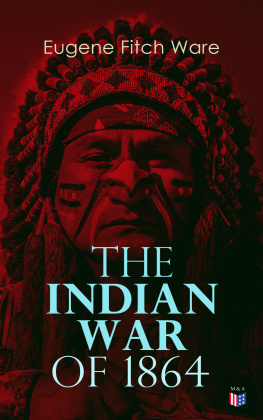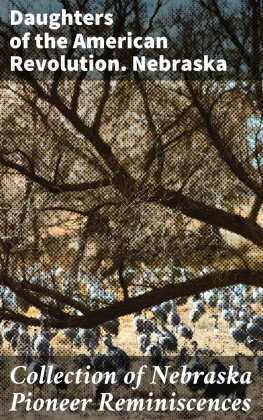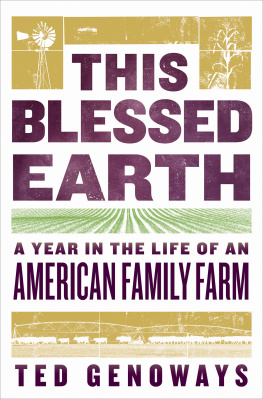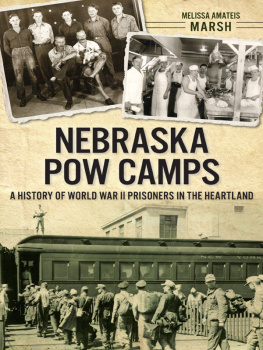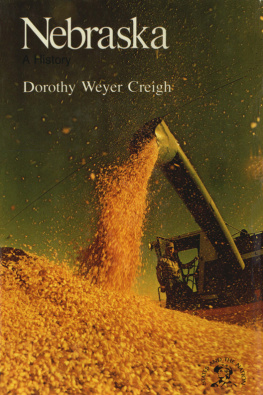C is for Cornhusker
A Nebraska Alphabet
J is a Journey across the vast prairieland of our nations 37th state. Join the friendly farmer for an alphabet adventure and discover a field of fascinating Cornhusker facts.
From the states eastern border along the Missouri River, where Lewis and Clark embarked on the Corps of Discovery expedition, to the towering geologic landmarks of the West, chronicled in pioneersjournals, there are treasures to explore on each page of C is for Cornhusker: A Nebraska Alphabet.
Traveling from A to Z, author Rajean Luebs Shepherd introduces readers of all ages to the enchantment of Nebraska through fun-filled rhymes and informative text that will entertain and educate. Artist Sandy Appleoff showcases the states unspoiled beauty and pioneer spirit through her whimsical watercolor illustrations.
...so open the pages and enjoy the journey.Welcome to Nebraska!
C is for Cornhusker
A nebrasha Alphabet

Written by Rajean Luebs Shepherd and Illustrated by Sandy Appleoff
In loving memory of Grandpa Henry Luebs,
who was born in 1895 on a homestead in Wood River, Nebraska.
A heartfelt thank you to:
my husband Stuart and sons Breton and Collinthe loves of my life
my wonderful parents... for teaching me, If at first you dont succeed, try, try again!
Up with People... for the memories of a lifetime.
Sleeping Bear Press, Amy Lennex, and Sandy Appleoff...for making a dream come true!
RAJEAN
Haizly and Dottie B, with special thanks to Helen Ravenhill,
Justin Newhouse, and the entire Appleoff family.
SANDY
So every man, woman and child shall be able to say, on coming
as I have come, towards the evening of life, in all sincerity
and truth, if you seek my monument, look around you!
J. STERLING MORTON
ARBOR DAY 1894
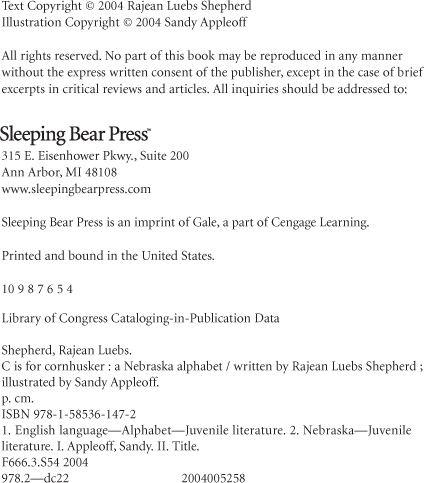
A
In pioneer days, the Nebraska Territory was almost treeless. However, Julius Sterling Morton, a journalist and politician from Nebraska City, changed that when he proposed setting aside a special day, each year, for planting trees. Mr. Morton said, Trees provide food for the table, wood for the stove, shade for the body, and beauty for the soul. On April 10, 1872, the first Arbor Day was celebrated and Nebraskans planted over one million trees, including cottonwood, Nebraskas official state tree. Today, all 50 states celebrate Arbor Day, as do other countries.
In 1902, the year that J.S. Morton died, President Theodore Roosevelt established Nebraska National Forest, the largest hand-planted forest in the United States.
Today many visitors tour the Mortons 52-room mansion at beautiful Arbor Lodge State Historical Park, especially on Arbor Day.
Lets travel the state of Nebraska and begin with the letter A.
For the planting of trees to help Mother Earth, its known as Arbor Day.

B
Born in Iowa in 1846, William Frederick Cody is a legend in the history of the American West. He was an expert rider and rifleman and his skill as a buffalo hunter earned him his nickname, Buffalo Bill. He once claimed to have shot 4,280 buffalo while working as a buffalo hunter for the men building the first railroad.
In 1882 William Cody staged Americas first rodeo, Old Glory Blowout, at his Scouts Rest Ranch in North Platte, Nebraska, now a state historical park. He then took his wild and woolly frontier show throughout the United States and Europe.
Cody died in 1917, but his legend lives on in many books, TV westerns, and in North Plattes annual events of Christmas at the Codys, held at his Victorian mansion, and the Buffalo Bill Rodeo held during NEBRASKAland Days.
B is for Bison and Buffalo Bill and his traveling Wild West Show.
With ropers, riders, and ranglers, it was our nations first rodeo.

C
In 1895 Nebraska was nicknamed the Tree Planters State in honor of Arbor Day, but in 1945 the legislature changed it to the Cornhusker State because of the importance of corn. The name, coined in 1900, is derived from the nickname for the University of Nebraska athletic teams, the Cornhuskers. A cornhusker is someone who peels the husks of corn by hand, which was a common method of harvesting before modern machinery.
Nebraska is known as a leading farming and ranching state where a larger percentage of total land is used for producing crops and livestock than in any other state. As Willa Cather, the Pulitzer Prize-winning author from Red Cloud, Nebraska, expressed it, Elsewhere the sky is the roof of the world, but here the earth is the floor of the sky.
Cornhusker begins with the letter C.
Its the nickname of our state.
And for the crops and cattle, that make this land so great.

D
Each spring the skies of Nebraska dance alive with the amazing sights and sounds of the worlds largest gathering of sandhill cranes. Eighty percent of the worlds population, approximately 500,000 birds, make the migratory journey from Mexico and the southern United States to the northern parts of Canada, Alaska, and Siberia.
Nebraska takes its name from its outstanding natural feature, the Platte River. Native Americans called the shallow, braided river nebrathka, meaning flat or broad water. This official state river is a favorite rest stop for the migrating sandhill cranes, where they parachute to the ground with their dangling legs. Here they feed on delicacies while roosting on the river sandbars, where they are protected from their predators. They also feast on a banquet of grain from the nearby cornfields.
The spirit of these stately, long-legged, long-necked birds is best characterized by the amusement of their captivating dance that includes bowing, arching, leaping, and stick tossing.
D is the Dance of sandhill cranes, as they bow and leap and fling.
Half a million come to roost, when they migrate north each spring.

E
In 1803 President Thomas Jefferson bought a large expanse of land, west of the Mississippi River, from France. This sale, known as the Louisiana Purchase, doubled the size of the new nation. President Jefferson then chose army officers Meriwether Lewis and William Clark to explore the new territory and search for an east-west water route connecting the Atlantic Ocean to the Pacific Ocean.
The expedition, known as the Corps of Discovery began in May 1804 on the Missouri River, in a keelboat and two pirogues or dugout canoes, and followed what is now the eastern border of Nebraska. En route, Lewis and Clark met Sacagawea, a Shoshone Indian, who became an important interpreter and guide.
Lewis and Clark did not discover the fabled Northwest Passage on their 8,000-mile roundtrip journey, which lasted over two years. However, through detailed observations, recorded in their journals, they succeeded in sharing their knowledge of Native American tribes,geography, plants and animals, and paved the way for future explorers.


